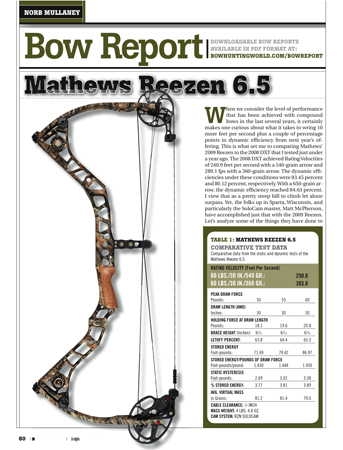Mathews Reezen 6.5 Bow Report
*Download the Bow Report*
 When we consider the level of performance that has been achieved with compound bows in the last several years, it certainly makes one curious about what it takes to wring 10 more feet per second plus a couple of percentage points in dynamic ef? ciency from next year’s offering. This is what set me to comparing Mathews’ 2009 Reezen to the 2008 DXT that I tested just under a year ago. The 2008 DXT achieved Rating Velocities of 240.9 feet per second with a 540-grain arrow and 289.1 fps with a 360-grain arrow. The dynamic ef?ciencies under these conditions were 83.45 percent and 80.12 percent, respectively. With a 650-grain arrow, the dynamic ef? ciency reached 84.63 percent. I view that as a pretty steep hill to climb let alone surpass. Yet, the folks up in Sparta, Wisconsin, and particularly the SoloCam master, Matt McPherson, have accomplished just that with the 2009 Reezen. Let’s analyze some of the things they have done to reach new heights in performance.
When we consider the level of performance that has been achieved with compound bows in the last several years, it certainly makes one curious about what it takes to wring 10 more feet per second plus a couple of percentage points in dynamic ef? ciency from next year’s offering. This is what set me to comparing Mathews’ 2009 Reezen to the 2008 DXT that I tested just under a year ago. The 2008 DXT achieved Rating Velocities of 240.9 feet per second with a 540-grain arrow and 289.1 fps with a 360-grain arrow. The dynamic ef?ciencies under these conditions were 83.45 percent and 80.12 percent, respectively. With a 650-grain arrow, the dynamic ef? ciency reached 84.63 percent. I view that as a pretty steep hill to climb let alone surpass. Yet, the folks up in Sparta, Wisconsin, and particularly the SoloCam master, Matt McPherson, have accomplished just that with the 2009 Reezen. Let’s analyze some of the things they have done to reach new heights in performance.
The Reezen is built on a fully machined 6061 T-6 aluminum alloy handle with limb mounting surfaces that are about 1/2 inch shorter than the DXT and set at an angle to mount the limbs closer to parallel. At brace height the limbs are parallel. At full draw the limbs point inwardly. If they were long enough they would intersect. I don’t know whether this adds to performance, but the action of the two limbs totally opposes each other with no forward vector. This is optimum for shock-free operation. The limb mounting systems on the two bows are very similar except that the fulcrum spacing on the Reezen is about a half inch shorter, allowing the working or bending portion of the limb to be that much longer.
The axle-to-axle length of the Reezen is nominally 32 inches compared to the DXT at 29 3/4 inches. The Reezen handle features a counter-bored hole for mounting a bow quiver on each of the upper and lower risers. The dynamic damper on the lower riser has a new dumbbell-type weight in place of the regular damper weight. It is my understanding that this heavier type of weight is a replacement for the standard weight in order to eliminate a vibration that could exist in some bows. The word is that it does an excellent job of this. *Read the rest of the report by downloading the PDF






